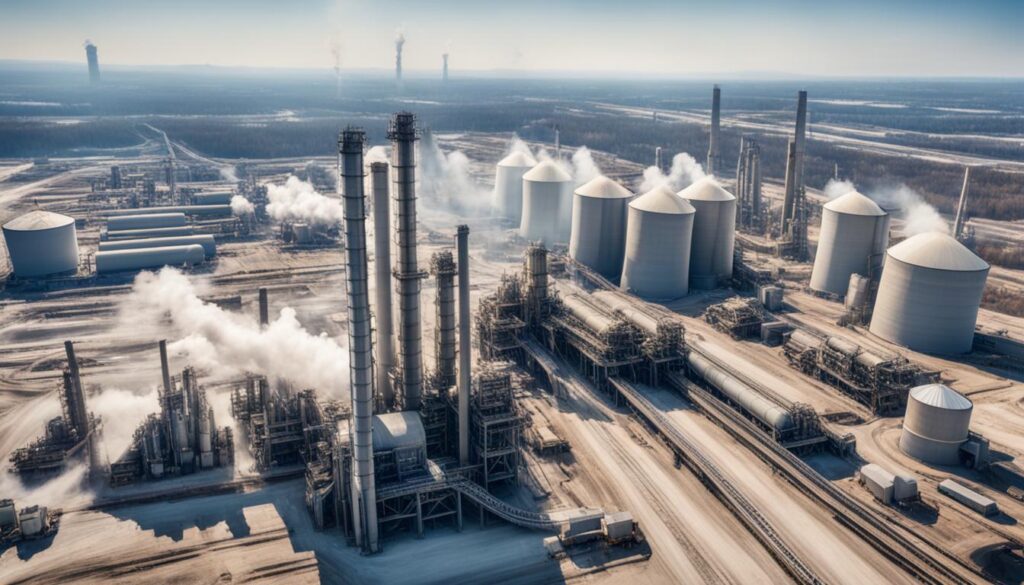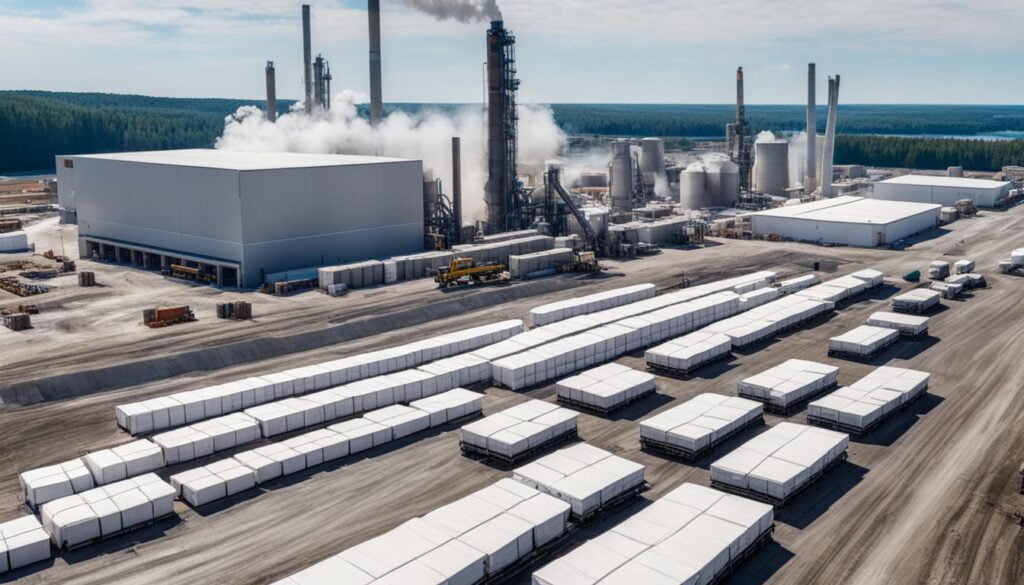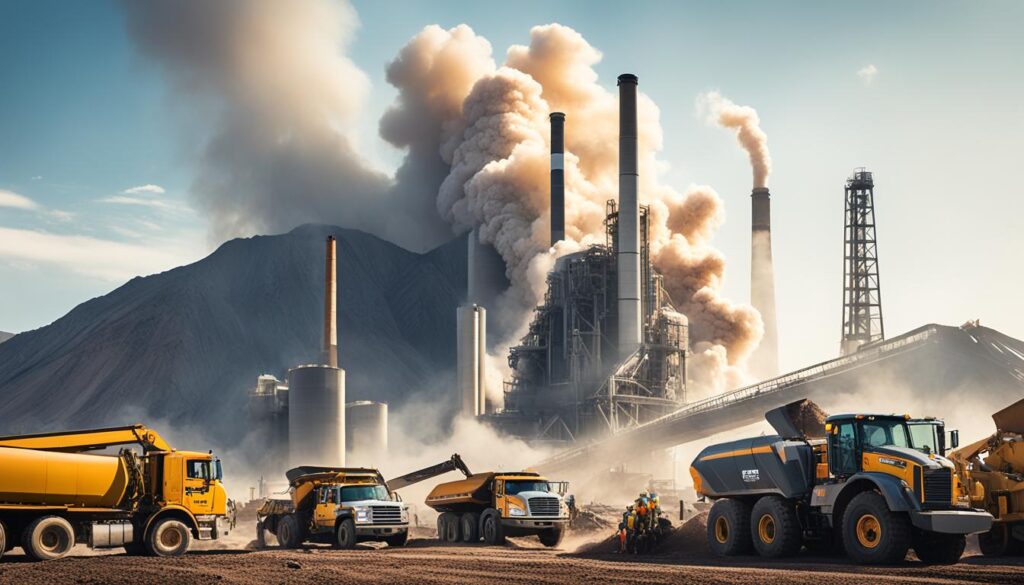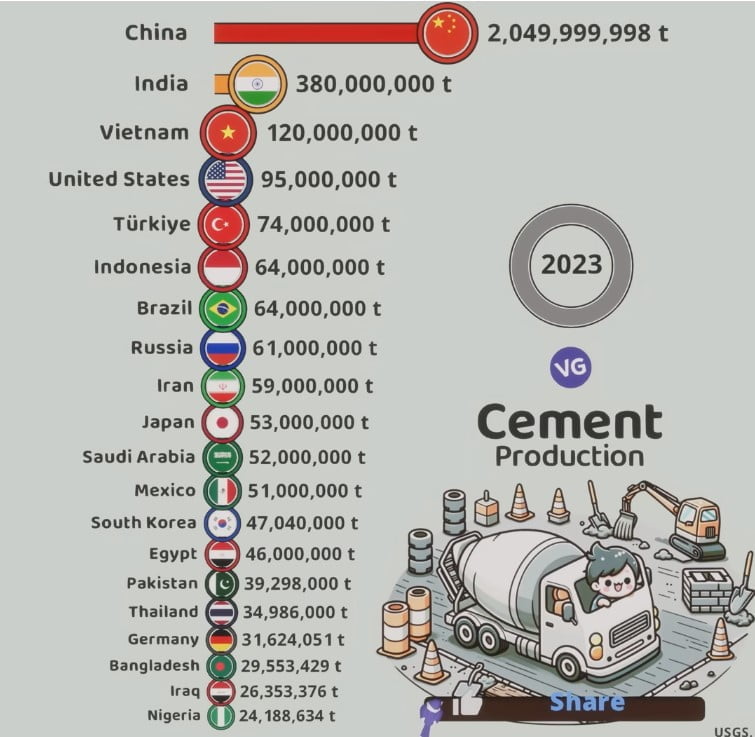The world’s cement industry is controlled by a small number of major companies. These top players have a big part of the market.1 Usually, these leading cement makers can produce millions of tons each year.1 They have plants all over the world, adding up to a huge chunk of all cement made globally.1
| Country | Cement Production (t) | Flag |
|---|---|---|
| China | 2,049,999,998 | 🇨🇳 |
| India | 380,000,000 | 🇮🇳 |
| Vietnam | 120,000,000 | 🇻🇳 |
| United States | 95,000,000 | 🇺🇸 |
| Türkiye | 74,000,000 | 🇹🇷 |
| Indonesia | 64,000,000 | 🇮🇩 |
| Brazil | 64,000,000 | 🇧🇷 |
| Russia | 61,000,000 | 🇷🇺 |
| Iran | 59,000,000 | 🇮🇷 |
| Japan | 53,000,000 | 🇯🇵 |
| Saudi Arabia | 52,000,000 | 🇸🇦 |
| Mexico | 51,000,000 | 🇲🇽 |
| South Korea | 47,040,000 | 🇰🇷 |
| Egypt | 46,000,000 | 🇪🇬 |
| Pakistan | 39,298,000 | 🇵🇰 |
| Thailand | 34,986,000 | 🇹🇭 |
| Germany | 31,624,051 | 🇩🇪 |
| Bangladesh | 29,553,429 | 🇧🇩 |
| Iraq | 26,353,376 | 🇮🇶 |
| Nigeria | 24,188,634 | 🇳🇬 |
Holcim stands as the biggest cement maker worldwide, with operations in 90 countries. It boasts 180 plants and a yearly production capability of 386 million tonnes.2 Anhui Conch Cement Company Limited is next, running 32 plants that turn out 288 million tonnes annually.2 China National Building Material Company (CNBM) is owned by China’s government. It leads in quantity, owning 94 plants and producing 176.22 million tonnes each year. It’s also Asia’s top maker of fiber glass.2
Other big names in the industry include HeidelbergCement, based in Germany. It operates in over 60 countries with 79 plants, making 121 million tonnes yearly.2 CEMEX comes next, calling Mexico home but working in more than 50 countries. It has 56 plants and can produce 87 million tonnes each year.2 Lastly, there’s Italcementi from Italy with 60 factories and a yearly production capacity of 76.62 million tonnes.2
The cement sector is key for building worldwide infrastructure. The biggest cement companies heavily influence global construction. This piece explores the top cement firms, looking at their production, global reach, and market influence.
Key Takeaways
- A handful of major cement companies dominate the industry.
- These companies have the ability to produce millions of tons each year.
- They operate numerous plants globally.
- Their cement production is a sizeable part of the global output.
- Their financial might and market positions are clear from their revenues.
Introduction to the Cement Industry
Cement is key in building infrastructure, structures, and buildings globally. It’s pivotal for a country’s economy growth through supporting construction. A large business, cement is made in many countries.1
Importance of Cement in Construction
Cement is important in construction, binding materials together. It helps build roads, bridges, and more, letting communities grow. This makes it crucial worldwide.
Global Cement Production Statistics
Global data on cement production shows its huge economic impact. The cement market was worth US$ 363.2 Billion in 2022 and is poised to hit US$ 518.5 Billion by 2028. This marks a strong growth at a 6.22% rate from 2023 to 2028.3
Holcim: The World’s Largest Cement Producer
Holcim became the biggest cement maker after Lafarge and Holcim merged in 2015. This move put them on top, with operations in 90 countries. They run 180 cement plants and can produce 386 million tonnes every year. This makes them the largest cement company worldwide.
Merger of Lafarge and Holcim
In 2014, the Lafarge and Holcim merger was huge, with a value of nearly $60 billion. It created a top player in the building materials industry.4 This new company is called LafargeHolcim. By 2019, it had reached sales of CHF 26.7 billion and employed about 72,000 workers around the world.5
Production Capacity and Global Presence
Since its start in 1912 in Switzerland, Holcim has grown worldwide. It started expanding in the 1950s-90s with investments in places like Europe, Egypt, and South Africa.5 Now, as LafargeHolcim, they have become the leading global cement maker. They can produce 286.6 million tonnes a year. They have a total capacity of 386.5 million tonnes. The company is in 70 countries, running 180 plants across the globe.5
Anhui Conch Cement: The Cement Giant of China
Anhui Conch Cement started in 1997 in China and is now the second-largest cement maker worldwide.2 They have 32 plants that can produce 288 million tonnes of cement each year. This makes them a key player in the cement industry in China.2 Their growth has been impressive, putting them at the forefront of cement producers globally and in cement production worldwide too.
This company is the biggest in making and selling cement in mainland China.6 They listed shares in the Hong Kong Stock Exchange on October 21, 1997, and in Shanghai on February 7, 2002.6 The main owner is Anhui Conch Holdings, and Conch Venture Investment is a big shareholder too. They make and sell cement and clinker.6
Anhui Conch Cement has grown quickly, making it a key player globally. It is the biggest cement maker on the planet and ranks in the top ten. Their clever investments and strong work ethic have helped them succeed. They meet the world’s need for cement, leading as the largest producer worldwide.
Being the biggest cement maker globally, Anhui Conch Cement is an essential part of the cement industry worldwide. It’s a major player in global cement production, cement producers worldwide, and in each nation’s cement market. They focus on growing their world cement production. This strategy keeps them as leaders in the cement industry globally.
China National Building Material Company (CNBM)
China National Building Material Company, or CNBM, is a big name in China’s building materials scene. It’s a state-owned enterprise. They focus on making and sharing building stuff like cement, gypsum, and fiberglass.2 CNBM runs 94 cement plants and can make 176.22 million tonnes of stuff yearly. This makes them the main fiberglass maker in Asia. They’re also big in the world’s cement game.7
State-Owned Enterprise in China
CNBM is key in China’s building world because it’s run by the state. It got onto the Hong Kong Stock Exchange through an IPO on March 23, 2006. This was a big step for them, showing their steady growth.7
Diversified Portfolio and Production Capacity
Aside from cement, CNBM makes other important building materials like gypsum and fiberglass. With a huge capacity to make 176.22 million tonnes of cement each year, they are a top player worldwide.
CNBM is always working on growing and improving its place in the market. For example, they teamed up with Qatari Investors Group in 2013. This partnership aimed to boost the production capacity at the Al Khaliji Cement plant.7 They’ve also bought companies in the solar technology field. This move helps CNBM become part of the green energy market too.7

HeidelbergCement: A German Construction Powerhouse
HeidelbergCement is a key name in the global cement sector, hailing from Germany.8 Since its founding in 1874, it has grown to have operations in more than 60 nations. They operate 79 cement plants that can produce up to 121 million tonnes of cement yearly.9 The company focuses on making cement, aggregates, concrete, and asphalt. It’s also big on implementing green solutions to lower its environmental impact.
Global Footprint and Product Range
HeidelbergCement is big worldwide, in places that make up the top cement producing countries. They rank among the largest producers, making them a key player in the global market.9 Their wide range of products, from cement to asphalt, helps solidify their position. They are among the top ten companies in the industry globally.
Sustainability Initiatives
The company is also focused on the environment, pushing for green practices.9 They plan to cut carbon emissions at their Mitchell plant by 2030, aiming for a 33% drop already. This shows their dedication to being more sustainable and tackling the sector’s environmental issues.
The Largest Cement Producers in the World
Several key players own the cement industry. They have large production sites and sell globally. Holcim, Anhui Conch Cement, and others like them are the top producers. They make up a big part of global cement making. Their work is vital for building and growing infrastructure around the world.2
In 2015, Lafarge and Holcim merged to make Holcim. It’s known as the biggest cement maker worldwide. Holcim operates in 90 countries, running 180 plants that produce 386 million tones a year. It is a big name in the industry.2 Anhui Conch Cement follows, with 32 plants making 288 million tonnes yearly.2 CNBM comes next with 94 plants and an output of 176.22 million tonnes a year.2
HeidelbergCement is a major player, based in Germany. It started in 1874 and now serves over 60 countries. It has 79 plants that produce 121 million tonnes each year.2 CEMEX, from Mexico, operates in more than 50 countries. It has 56 plants making 87 million tonnes per year.2 Italcementi has its base in Italy and has 60 plants, producing 76.62 million tonnes yearly.2
China Resources Cement Holdings comes next, based in the Cayman Islands. It makes 71 million tonnes in a year.2 Taiwan Cement Corporation has an output of 64 million tonnes yearly from six plants.2 Eurocement is the top producer in Russia. It runs 17 plants, making 45 million tonnes a year.2 Votorantim Cimentos, located in Brazil, makes 45.02 million tonnes from 34 plants.2
These top companies are successful because of their large capacities, wide variety of products, and global presence. They meet the world’s growing need for cement and construction materials. This keeps them at the top of the cement industry.
CEMEX: The Mexican Cement Leader
CEMEX is a top player in the worldwide cement scene. It’s an expert in construction materials. Based in San Pedro, Mexico, the company started in 1906. Now, it’s found in more than 50 countries, with 56 cement plants. They can produce up to 87 million tonnes of cement every year.10
Expansion and Acquisitions
In 2005, CEMEX got even bigger by buying RMC Group. This UK-based company did ready-mix concrete and made concrete products. CEMEX’s growth includes making big moves like getting into Thailand in 2001. Plus, in 2005, they picked up the UK’s RMC Group too.11
Ready-Mix Concrete and Aggregates
CEMEX doesn’t just do cement. It also handles ready-mix concrete and quarry materials. This makes them stronger in the construction world. They focus on getting and providing materials, making cement, ready-mix concrete, and concrete products.11
CEMEX is a huge deal thanks to its wide range of products and many locations. By smart acquisitions and growing its work, CEMEX is a key name in making cement, all around the globe. significant player in the global cement industry. With its strategic acquisitions and focus on expanding its operations, CEMEX continues to solidify its position as a leading cement producer worldwide.1011
Italcementi: An Italian Cement Multinational
Italcementi is a big name in the world of cement and construction materials. It’s all about making cement, mixing concrete, and more.12 Since 1846, it has been a key player. It’s now spread around the globe with 60 cement factories. They can produce a huge 76.62 million tonnes a year.12 Italcementi’s wide range of products and its global presence make it very important in the cement industry.
History and Global Reach
In the early 1920s,12 Italcementi merged with a group of companies. This created a powerful force with 12 plants and over 1500 workers. Together, they could make more than 200 tons of cement each year.
After this, in 1927, they officially became Italcementi. Two years earlier, in 1925, they joined the Italian stock market.12 Their journey to becoming a global company started in 1992. That’s when they bought Ciments Français and became the world’s leading cement maker.
Italcementi kept growing. By 1998, they had spread to different countries. They picked up new cement plants in places like Bulgaria, Kazakhstan, and the United States.
They didn’t stop there. In 2015, they amazed the industry with a special type of cement. It can actually clean the air! Italcementi also increased its ownership of Ciments Français to nearly 98% that same year.
12 A big moment came in 2015 when HeidelbergCement bought 45% of Italcementi. This move made them the second-biggest cement company worldwide. With more than 20,000 workers, Italcementi has a strong team worldwide. They are in 22 countries, from Italy to the U.S.
Most of Its sales, about 60%, are from cement. But they also sell a lot of ready-mix concrete and aggregates. Italcementi has cement plants, quarries, and more all across the globe. Italmobiliare, a company in Milan, owns Italcementi. They are listed on the Borsa Italiana.

China Resources Cement Holdings
China Resources Cement Holdings is the seventh-largest cement maker globally. It has a big output of 71 million tonnes per year. The company is based in the Cayman Islands but has its main office in Hong Kong. It is the top cement maker in southern China.
Largest Cement Producer in Southern China
By June 30, 2022, the company operated 95 cement grinding lines and 46 clinker production lines. They have the capacity to make 83.3 million tons of cement and 61.1 million tons of clinker yearly.13 The highest concentration of production lines is in Guangxi, with 37 cement lines and 18 clinker lines. These add up to 3.32 million tons and 2.65 million tons, respectively.13 With partnerships, they run 79 cement grinding lines and 30 clinker production lines too. This adds another 66.4 million tons of cement and 37.0 million tons of clinker capacity.13
China Resources Cement also owns 63 concrete batching plants that make 37.9 million cubic meters of concrete a year. They have interests in 20 more plants that produce an additional 9.8 million cubic meters annually.13 In 2021, they joined prefabricated construction, working on 5 projects and having 2 more in the works. Once finished, these projects will have a capacity of making 1.6 million cubic meters of precast concrete components each year.13
Taiwan Cement Corporation
Taiwan Cement Corporation is all about making cement, concrete, and other building materials. Since 1946, it’s been a big name in the industry, producing 64 million tonnes of cement yearly across its six plants. It’s a key player in the global market.14
Cement Machinery and Furnace Powder
Besides cement, this company also creates machinery and furnace powder. This broadens what they can offer and boosts their standing worldwide.14
Their production sites are smartly placed, with most on Taiwan’s east coast.14 This helps them efficiently meet the area’s building and infrastructure demands.
Asia Cement Corporation, a Taiwan Cement offshoot, can make 5 million tons in Taiwan and 22 million in China.14 Taiwan Cement itself produces 11 million in Taiwan and a whopping 60 million in China.14 With these huge capacities, they’re a top producer in the Asia-Pacific area.
In 2016, Taiwan sold more than a quarter of its cement abroad and brought in 12%.14 This trade shows their strong international position and growth potential.
Notably, Taiwan Cement supports Native workers, with half its Asia Cement workforce being from indigenous groups.14 This move highlights their drive for a fair and sustainable business model.

Eurocement: Russia’s Cement Giant
Eurocement is a leading producer of building materials in Russia, launched in 2002.2 It operates in Russia, Uzbekistan, and Ukraine, owning 17 cement plants. These plants can produce a total of 45 million tonnes every year.2 With a big presence across Eastern Europe, Eurocement is a key player in the area’s cement business.
Presence in Eastern Europe
Eurocement’s main office is in Moscow, giving it a strong position in Eastern Europe’s cement market.15 In 2011, the company made ₽ 55.7 billion in revenue. It also had a net income of ₽ 10.2 billion.15 By 2014, Eurocement had over 20,000 workers. Its cement and concrete production capacity was at 40 million tons and 10 million cubic meters, respectively.15
The firm also boasts vast reserves of carbonate rock (2.8 billion tonnes) and granite (1.8 billion tonnes).15 This ensures a steady flow of raw materials for its operations.15 Additionally, Eurocement has landed major deals with Chinese firms, reaching $530.7 million in 2014.15 It is also building new cement plants that will add 17 million tons to its yearly capacity.15
In 2021, the Mikhailov Construction Materials Plant bought Eurocement’s shares and debts for 161 billion rubles.15 This move further solidified Eurocement’s standing in the cement markets of Russia and Eastern Europe.
Votorantim Cimentos: Brazil’s Cement Leader
Votorantim Cimentos is Brazil’s biggest cement company. It ranks 10th worldwide in cement production. It can make 45.02 million tonnes of cement a year from 34 plants. Apart from cement, it makes aggregates, mortar, and ready-mix concrete. This makes it key in Brazil’s cement and construction materials market.16
Aggregates and Ready-Mix Concrete
Votorantim Cimentos offers more than just cement. It provides aggregates and ready-mix concrete too. This wide range helps it stand strong in Brazil’s construction materials scene. With big production and locations around the globe, it’s a major player in the cement industry.
Votorantim Cimentos focuses on the Brazilian market. With its wide range of products, it’s become Brazil’s cement leader. It helps with the country’s growth through new infrastructure and buildings.
16
CompanyAnnual Production Capacity (million tonnes)Number of PlantsHeadquarters
| Holcim | 386 | 180 | Switzerland |
| Anhui Conch Cement | 288 | 32 | China |
| CNBM | 176.22 | 94 | China |
| HeidelbergCement | 121 | 79 | Germany |
| CEMEX | 87 | 56 | Mexico |
| Italcementi | 76.62 | 60 | Italy |
| China Resources Cement Holdings | 71 | N/A | China |
| Taiwan Cement Corporation | 64 | 6 | Taiwan |
| Eurocement | 45 | 17 | Russia |
| Votorantim Cimentos | 45.02 | 34 | Brazil |
Factors Driving the Cement Industry
The need for cement is growing because we’re building more. Think about all the roads, bridges, and buildings. It’s a big part of making our world better. Also, as more people live in cities, we need even more cement.17 This adds to the boom in the cement business. The top companies are working hard to keep up with the demand.
Infrastructure Development
When the economy is doing well, we build more. This means a lot of new roads and bridges are made. And guess what? They need a ton of cement.18 So, the economy and the cement industry are very connected. Countries build their future with cement in hand.
Urbanization and Population Growth
More people are moving to cities all over the world. This move means we need tons of new houses and buildings. And, you guessed it, we need lots of cement for them.18 The push to build more in cities keeps the cement industry growing. It’s a major reason the industry is bigger now than ever before.
Challenges Faced by Cement Producers
The cement sector is vital for our global infrastructure. Yet, it grapples with numerous hurdles. These include concerns for the environment and hefty energy expenses. Making cement uses a lot of energy and it emits greenhouse gases. This has led to worries about its long-term sustainability.19 To battle these issues, cement makers are pushed to turn to greener ways. This includes using different materials and fuels that are friendlier to the planet.20
Environmental Concerns
About 7% of the planet’s CO2 comes from making cement.20 The process involves heating raw materials at super high temperatures, which releases a lot of CO2. Almost half of the emissions from making cement come from burning fuel to heat the kilns.20 The rest is from the chemical reaction during clinker production. It’s a big challenge for the industry as more people focus on the environment.20
Energy Costs and Sustainability
Aside from environmental worries, the cement world faces issues with energy costs and the push for sustainable practices. Producing one ton of cement needs a lot of fuel and electricity. The ups and downs of energy prices and the call for using energy better are tough for the industry.19 Cement makers are looking at new ideas to become more sustainable and save money.19
It’s projected that cement emissions might increase up to 17% or drop by as much as 39% by 2050, with a 67% possibility.19 Moving to a low-carbon cement future is doable by cutting clinker use, using different materials and fuels, and updating how cement is made.21 The industry is working on new technologies like capturing carbon, using hydrogen and electric kilns, and rethinking how they make cement chemically. These efforts aim to solve the challenges of sustainability and lower the industry’s environmental impact.19
Trends and Innovations in Cement Production
The cement industry is making big changes to overcome challenges and be more eco-friendly. It’s now using things like waste and plants as fuel and materials. This move cuts back on the need for fossil fuels and lessens harm to the planet.19
Alternative Fuels and Raw Materials
Cement makers are turning to new ways to power and supply materials. They’re using materials like waste and leftover stuff from other industries, as well as plants.19 This step not only lowers the industry’s pollution but also helps recycle trash.
Digital Transformation and Industry 4.0
On top of new materials, the cement world is diving into digital and smart technologies. These changes boost how well things run, making processes smarter and cutting down on errors.22 The setup uses things like automatic systems, smart data, and a web of connected devices. This lets cement makers upgrade their work, save on power, and keep a closer eye on what they’re making.
All these updates help cement makers stay sharp in the market and meet new rules. With the right tech and materials, they can keep up in a more earth-friendly way.1922 It shapes a future where building is kinder to our planet.
Conclusion
A few big companies lead the global cement scene. They have many plants and make a lot of cement every year. For instance, Holcim has 180 plants and can make 386 million tonnes of cement yearly2. Anhui Conch in China has 32 plants and makes 288 million tonnes annually2. CNBM, also in China, owns 94 plants and produces 176.22 million tonnes yearly2. These leaders meet the world’s need for more cement as cities grow and new buildings go up2.
The cement business is looking to the future. It’s working on how to be less harmful to the planet and save on energy. Big players like LafargeHolcim have 180 plants in 70 countries. They can produce 386.5 million tonnes of cement each year5. The industry is aiming to be greener and more efficient. Doing this helps keep the world building and growing economically5.
China stands out by making the most cement, over 2,100 million metric tons each year23. This makes it the number one producer globally. But, other countries like India, Vietnam, the United States, and Turkey aren’t far behind. These nations play a big part in how and where new buildings and projects happen23.
FAQ
What are the largest cement producers in the world?
The biggest cement makers globally include names like Holcim and Anhui Conch Cement. Others are China National Building Material Company (CNBM), HeidelbergCement, and CEMEX. All these companies help build our world.
What is the importance of cement in the construction industry?
Cement is key in creating roads, buildings, and more worldwide. It’s essential for any country’s growth and helps the construction industry expand.
What are the global cement production statistics?
Cement is a big part of the world economy, with lots produced across many areas. This industry is crucial for making our buildings and infrastructure.
What is the production capacity and global presence of Holcim, the world’s largest cement producer?
Holcim leads as the top cement producer worldwide. After Lafarge and Holcim merged in 2015, they became even stronger. Holcim is in 90 countries, operating 180 cement plants yearly producing 386 million tons.
What is the status of Anhui Conch Cement Company Limited as a cement producer in China?
Anhui Conch Cement Company Limited is China’s second-largest cement maker. It began in 1997 and has a large operation. With 32 plants producing 288 million tons each year, they are a major player in China.
What is the role of China National Building Material Company (CNBM) in the global cement industry?
CNBM is a big player in building materials, including cement, in China. It’s a state-owned business leading in Asia’s fiberglass production. With 94 cement plants, CNBM makes 176.22 million tons a year and is a global cement giant.
What are the key features of HeidelbergCement, a prominent player in the cement industry?
HeidelbergCement is a German company known in the cement world. Since 1874, it’s been in over 60 countries. With 79 cement plants producing 121 million tons yearly, it focuses on cement, aggregates, concrete, and asphalt. It’s also big on being eco-friendly.
What is the market position and operations of CEMEX, the Mexican cement leader?
CEMEX is a Mexican company making its mark in global cement. Since 1906, they’ve been in over 50 countries. With 56 cement plants, they make 87 million tons a year. They also do ready-mix concrete and, through smart acquisitions, they’re staying strong as a cement leader.
What is the history and global reach of Italcementi, the Italian cement multinational?
Italcementi represents Italy in making cement all over. Formed in 1864, they have 60 cement factories internationally. Their yearly 76.62 million tons reflect their reach and impact.
What is the status of China Resources Cement Holdings as a cement producer in southern China?
China Resources Cement Holdings stands out in southern China. As the seventh-largest in the world, they produce 71 million tons a year. Based in Hong Kong, they meet high demand for cement in the region.
What are the key products and production capacity of Taiwan Cement Corporation?
Taiwan Cement Corporation focuses on cement and related products. Since 1946, they’ve grown to six plants, making 64 million tons of cement yearly. Their work is crucial in the cement industry.
What is the presence and production capacity of Eurocement in Eastern Europe?
Eurocement is a big deal in construction in Russia since 2002. Headquartered in Moscow, they also operate in Uzbekistan and Ukraine. With 17 plants making 45 million tons a year, they shape the region’s cement industry.
What is the status of Votorantim Cimentos as the largest cement company in Brazil?
Votorantim Cimentos leads Brazil’s cement market. Their 34 plants produce 45.02 million tons yearly. They also do aggregates, mortar, and ready-mix concrete, truly ruling the Brazilian scene.
What are the factors driving the growth of the global cement industry?
Cement is needed worldwide as more buildings and infrastructure are built. Demand comes from new construction and the growth of cities. This drives the need for more cement.
What are the challenges faced by the cement industry?
Environmental issues and the high cost of energy trouble the cement sector. Making cement uses a lot of energy, which isn’t good for the planet. Companies work to be greener and cut their energy use.
What are the trends and innovations in the cement industry?
The cement world is working on being more sustainable. Using new fuels and materials helps cut down on the need for energy. The digital revolution is also helping to make operations in cement more efficient.
Source Links
- https://finance.yahoo.com/news/20-largest-cement-producing-countries-142155332.html
- https://www.constructionkenya.com/5390/largest-cement-companies-world/
- https://www.imarcgroup.com/top-10-cement-companies-worldwide
- https://en.wikipedia.org/wiki/Holcim
- https://datis-inc.com/blog/what-is-the-largest-cement-producer-in-the-world/
- https://en.wikipedia.org/wiki/Anhui_Conch_Cement
- https://en.wikipedia.org/wiki/China_National_Building_Material
- https://globalcement.com/magazine/articles/519-german-cement-focus
- https://www.insideindianabusiness.com/articles/heidelberg-unveils-mitchell-cement-plant-as-company-cornerstone-shortage-answer
- https://en.wikipedia.org/wiki/Cemex
- https://www.cemex.ae/careers/introduction-to-cemex
- https://en.wikipedia.org/wiki/Italcementi
- https://www.crcement.com.hk/home/MainBusinesses/index.html?flag=2
- https://en.wikipedia.org/wiki/Cement_industry_in_Taiwan
- https://en.wikipedia.org/wiki/Eurocement_group
- http://www.unitedmaterialsllc.com/Pages/mcinnis-success.aspx
- https://www.linkedin.com/pulse/cement-market-analysing-driving-factors-2030-industry-research-co
- https://www.suryagoldcement.com/blog/economic-factors-driving-the-cement-industry/
- https://rhg.com/research/the-global-cement-challenge/
- https://www.azom.com/article.aspx?ArticleID=22883
- https://www.cementirholding.com/en/sustainability/sustainability/cement-sector-and-challenges-of-sustainability
- https://www.worldcementassociation.org/blog/news/global-cement-industry-outlook-trends-and-forecasts
- https://worldunfolds.com/largest-producer-of-cement-in-the-world/



